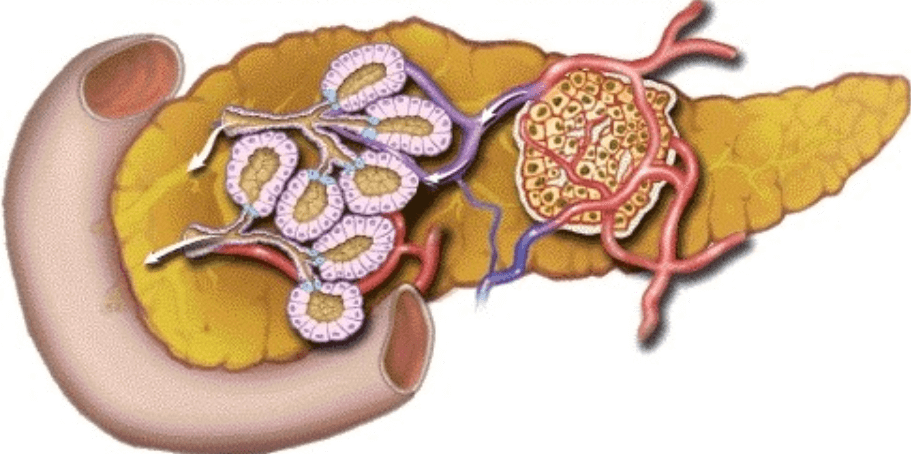What is the pancreas? Where is the pancreas in our body? Information about the pancreas structure. What are the exocrine and endocrine functions of the pancreas? Information about the functions and work of the pancreas.

Source: wikipedia.org
Pancreas; a soft yellowish gray gland with both exocrine and endocrine functions, which in the human being lies behind the stomach and in front of the first and second lumbar vertebrae of the spinal column. It is found in most vertebrates. About two to five ounces in weight and six to eight inches in length in the adult human body, it has an elongated J-shape, and lies transversely across the rear wall of the abdomen, its rounded head relating to the duodenum on the right and its narrow tail relating to the spleen on the left. It possesses an excretory duct for passage of pancreatic juice into the duodenum.
Exocrine Functions:
The main bulk of the pancreas consists of grapelike clusters of cells which manufacture digestive enzymes. The digestive enzymes in the pancreatic juice, along with enzymes produced by the intestinal lining, break down the larger organic molecules in food into smaller molecules, which then cross through the digestive lining into the lymph and blood circulation. The chief pancreatic enzymes are trypsin (protein splitting), amylopsin (starch splitting), and steapsin (fat splitting). Also secreted are the enzymes carboxypeptidase, aminopeptidase, maltase, sucrase, lactase, and various nucleases.
About one to one and one-half quarts of pancreatic juice are secreted in the adult organism daily; the rate of flow is under nerve and hormone control. The hormone secretin is released by the intestinal mucosa when stimulated by the acid chyme passing from the stomach into the intestine after eating. Secretin from the intestinal lining reaches the pancreas by way of the bloodstream, stimulating the flow of juice; thus pancreatic flow begins a minute or two after eating and continues until the stomach is completely empty. Nervous regulation is by the two components of the autonomic nervous system: vagal efferents increase flow; sympathetic efferents reduce it.
The pancreatic duct enters the intestine about three inches below the stomach, usually joining the common bile duct leading from the liver. Thus bile and pancreatic juice enter the intestine together.
Endocrine Function:
Spread out uniformly among the substance of the gland are small islands of endocrine cells (islands of Langerhans) which produce the hormone insulin, released directly into the blood capillaries that traverse the gland. Insulin is responsible for regulation of carbohydrate metabolism; inadequate production results in the metabolic illness diabetes mellitus. Insulin secretion is regulated by a pancreatotropic hormone, released by the pituitary gland and carried to the pancreas by the bloodstream.
Disorders:
The principal pancreatic disorders are inflammation (pancreatitis) ; cyst formation ; benign and malignant tumors; obstruction of the pancreatic duct; and functional disorders of enzyme production and flow. Disorders of the island cells are diabetes mellitus, resulting in reduced levels of blood insulin and high blood sugar; and islet cell tumor, usually benign, which results in high blood insulin and low blood sugar levels. Disorders of the bile passages, such as concre-ment or infection, may secondarily infect or obstruct the pancreatic passages. Pituitary disorders may secondarily affect the normal functioning of the insulin-producing cells.